|
|
|
Free a Feeling
How to talk to your child about their feelings so that they learn to understand them. Help raise your child's emotional intelligence.

September 4th, 2015 ¦ Marsha Jacobson -

At his wedding, my youngest son stood up to give his much anticipated speech. His reputation as a public speaker is well known and he didn’t disappoint. His two older brothers had spoken about his eccentricity and how, as much as they love him, he is the weirdest guy they know. Half way through his, on point, hilariously funny speech, he calmly addressed his brothers’ comments by walking to the centre of the dance floor, pulling down his pants and slowly mooning everyone, possibly performing the first ever groom-moon.
Along with many others, I gasped and I held my mouth, muffling the words – OMG. I can only describe what happened next as a piece of my life flashing before my eyes. I realized many things in a matter of seconds. Here they are:
- I raised my kids to follow their truth, so put my money where my mouth is.
- Just because I wouldn’t do it doesn’t mean it shouldn’t be done.
- This kind of humour makes him uniquely him and I love all of him.
- Who cares what other people think.
My perception went from horrifying to hilarious in seconds and I laughed harder than anyone. Turned out the “moon” was hilarious to most and to those who weren’t amused – tough! I felt incredibly proud that I had raised a kid who could step away from the expected and be so okay with it. And seriously, is this any more risqué than string bikinis?
My quirky son is a paediatric resident and appreciates fully the frequent tragedy of life. He has more than his fair share of anxiety and holds onto a strong moral code, heading, each year, a Movember team – in great humorous spirit as his moustache growth is puny at best. His ability to find the fun in a life that so often feels overwhelmingly heavy is completely necessary so that when he has to, he can be his best.
Unlike others, I am privy to my son’s back-story. I don’t feel I have to explain to anyone why I am so proud of his “mooning” but I am doing so, as I believe the lesson to us all is to judge the actions of others less quickly and less harshly. My son would laugh at this last statement as one of the things he is fond of saying is “I judge people quickly and harshly with very little information!” Did I mention he’s hilarious?
September 30th, 2014 ¦ Marsha Jacobson -

One of the most useful tools you can give your children is a coping mechanism for dealing with overwhelming worry. Whether your child is prone to this or not, this is an important skill, as excessive worry affects almost all of us at some point in our lives. As an adult I have learned, at times, to give myself permission to put aside my worries for a while to give me time to recharge emotionally. This in itself contributes to resolving the worry.
Children need something more concrete. After you’ve explained to them that they need and deserve a break from their worries (everyone does), you can suggest the following:
– Relaxation exercises (I will expand on these soon in future blogs)
– Doing something mindless that requires focus but not thinking. For example, cleaning their room, sorting your kitchen cupboard 🙂
– The Worry Waiting Room – This is an imaginary room in which children (and adults) can leave their worries temporarily. Have your child close their eyes, slow their breathing and when they are ready ask them to imagine a room. Spend some time with them creating this room with lots of details. Couches, TV, games, books etc can be placed here. It’s important that your child visualize this room as belonging to them. This is a space where they can place their worries in order to step back from them. The worries can take any form they like, such as boxes, heavy weights or any other way that your child imagines them. To help activate their imagination, you can tell them to look for their worries in the room in order to discover their form. Children have less trouble engaging their imaginations than we do!
Once they have stacked their worries somewhere in this room, you can teach them that they can return whenever they want to, take out one worry at a time, and deal with it. Tell them to let their other worries know that they will come back for them and that this room will keep them safe while they wait. You can help your child prioritize their worries by writing them down and then rating each one on a 1 – 10 scale.
The wonderful thing about a Worry Waiting Room is its ability to install a sense of control and sanity when it is most needed. Your child can be in control of their worries and when to deal with them. They have the capacity to manage them in whatever way they want, and the Worry Waiting Room will always be there for them when they need it.
January 2nd, 2014 ¦ Marsha Jacobson -
The idea that we can influence our child’s behavior by focusing only on their behavior is simply put, a recipe for disaster. I’m not saying ignore bad behavior – far from it. But if you separate your child’s feelings from the way they are behaving, you are not giving them the proper tools to guide their behavior going forward. Behavior stems from a feeling. It doesn’t happen in a vacuum. Changing your child’s behavior without allowing them to understand the connection to the way they are feeling will maybe give you short term change – not what most parents want.
All feelings, good and bad, are important and useful. In many different ways, understanding their feelings will help your child have better relationships with their friends, be more successful at school, and feel happier about who they are. Here are some ideas on feelings to ponder over:
- Understanding their feelings will help your child decide what they like and what they don’t, what they like doing and what they don’t like doing, and who they like and who they don’t. Their feelings guide them in decision-making. When their behavior follows what feels right for them, they are more likely to do things well and be happier overall, regardless of whether their feelings are good or bad.
- Bad things happen to every person. It is part of being human. At some point in their life your child will experience sadness, frustration, disappointment, and anger. Everyone does. Learning to understand these feelings will prepare them to deal with them better in the future. A healthy recipe for life’s happiness has to include feeling sad sometimes and acknowledging that.
- A person who understands their feelings will be able to better understand other people’s feelings. Understanding how other people feel is called empathy. To understand another person’s feelings does not mean you have to have the same experiences as them. For example, one child may be afraid of dogs and the other afraid of the dark. They may be afraid of different things, but the feeling of being afraid is similar.
- Having empathy helps you get along with others. When other people feel that you understand the way they feel, it makes them feel good about themselves and good about you. Good relationships happen when people understand each other’s feelings. (This is not specific to children)
Don’t be too quick to rush in and make your child feel better when they are sad, angry or scared. Let them experience the feeling and feel confident in the knowledge that with each minute that you allow them that experience, they are learning things about themselves that will help them face, with strength, a life that is not always kind.
August 12th, 2013 ¦ Marsha Jacobson -
When your child tells you they are feeling sad. Spend time exploring their story and let them know that you have heard it and understood it. You can do this by retelling it using words that they can understand. Use this retell as an opportunity to introduce them to other feeling words that describe their feelings – this can be a word they are unfamiliar with – as this is a great opening to increase their “feeling vocabulary.”
Once you feel your child is satisfied that you have understood their story and their feelings, you can elaborate, using questions like “Have you felt like this at another time?” or “How do you think the other child felt?” or “Why do you think they behaved that way.” These questions put your child in the mindset to learn from their experiences and to problem-solve.
June 18th, 2013 ¦ Marsha Jacobson -
Children don’t start out avoiding feelings of sadness, frustration or anxiety. They want to talk about them as much as they do the more comfortable feelings. But they quickly learn that these feelings are often taboo. Parents can make an enormous difference to this.
Children will often be your best guides and help you to help them talk about their feelings. Children ask questions, lots of them. Answer all your children’s questions with honesty, particularly when they are about negative feelings. Often, our initial reaction is to console, explain or eliminate negative feelings. This does not provide your child with the tools to deal with similar situations in the future.
For example, if your child expresses fear, avoid reactions like, “There’s nothing to be afraid of,” or, “Don’t be scared.” This can make your child feel unheard and shuts down communication. Accepting all of your child’s feelings, allows your child to accept their own feelings and work with them.
|
|
|








